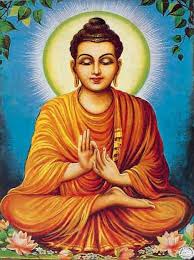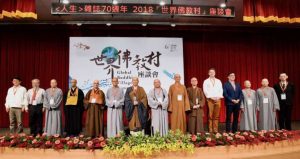
For many years I attended Losar retreat at my temple, Pema Osel Ling, in the Santa Cruz mountains of California. Ours is a lay householder sangha, not a monastery, although we often host traveling monastics from various places, welcoming them into our practice sangha and honoring them as the monastic community should be honored for their renunciation, devotion, and commitment. For me, as a Buddhist, it has always felt normal to be integrated with the householder and monastic sanghas, whether I’m at my home temple or visiting other temples or retreat centers in California, Portugal, and Brazil, whether in my lineage or other lineages. However, this is not true for all practitioners: some householders have never encountered a monastic sangha or traveled to countries where these practitioners are more visible in the culture and society. As our world changes, in many ways for the better, toward inclusion and acceptance, both lay and monastic Buddhists can feel the benefits. For those who cannot yet experience this, may their situation soon evolve.

The significance of the revival of lay meditation in the twentieth century has its counterpart in the revival of bhikkhunī ordination that is becoming a prominent feature of the early twenty-first century. Both result in improving the full participation of all four assemblies in modern Theravāda Buddhism.
(Barre Center for Buddhist Studies)
In the West, it is harder to maintain monastic vows and lifestyles in our capitalistic society, but in Asian cultures it has been historically the nuns and monks who have upheld the practices of the Buddhadharma and laypeople who have honored them through financial and social modes of support. Unfortunately, this is more common for monks than nuns as patriarchy exerts its bias in most parts of the world. Hopefully, that tide is changing. I have recently read many inspiring stories of positive developments for female ordained and householder Buddhists.
As our world grows ever smaller and closer, one benefit is that we continue to learn from one another and share our traditions, our experience, and knowledge to create more tolerance, connection, and mutual respect.

I hope to see more mutual understanding and respect, born of a true willingness to listen, learn, and include the “other.” As Ayya Yeshe states:
. . . part of it is simply the capitalistic impatience of our age—in a society that measures success materially, monasticism just doesn’t make sense. . . . Any system made by unenlightened beings is imperfect, but real Dharma practice is about facing hard things and stripping away what is untrue—even our fantasies about how Buddhist institutions should be. We need to renew the fourfold sangha. We don’t need to internalize or perpetuate dysfunction.
(Lion’s Roar)
When I was in long retreat, each of us was supported by patrons to whom we wrote initially requesting funding, and through the duration would periodically check in and send our thanks. It is said in traditional scripture that the patron living in town and the yogin meditating on the mountainside reach enlightenment together due to their interdependence and merits. The sangha is mutually supportive in the best of circumstances.
Likewise, monastics, nuns and monks, are supported in part by donations from laity and wealthy patrons who do not themselves have time for extended practice retreats, but value them nonetheless, as an essential way to uphold the lineages and practices of Buddhist meditation. Incidentally, many Westerners do not understand that long retreats, of 1, 3, 6, or 12 years, also entail some monastic vows for the duration. Or that it is possible and acceptable in Buddhism to be monastic for a period of time, not always life-long, and that there is no shame or stigma with that. Even temporary monastic vows are extremely beneficial for a practitioner.

Most joyful is when laity and monastic practitioners join in the temple and practice together, particularly at such auspicious and beloved times as Losar, or Lunar New Year. I imagine settings in the original Buddhas’ historical experience wherein all four sangha aspects were present, and the 5th, animals, listening attentively outdoors to the Buddha’s discourse. Who knows if this happened or not, I believe my wish that it did is what matters most. Scholar Wendy Garling has much to offer on the subject in her excellent research work, Stars at Dawn:
The Buddha had just attained the supreme state of enlightenment and had much work to do in the world. Not only did he rebuff Mara’s cruel counsel, but in that moment, he made a vow and laid out a blueprint for his ministry: all believers in his faith—women and men, lay and ordained, would become wise and accomplished through his teachings. Within these four groups, some would also achieve sufficient knowledge and insight to teach the sacred Dharma to others, and so the Dharma would flourish into future generations. Not until that took place would he leave this world. With this statement, the Buddha declared the four assemblies—laywomen, laymen, nuns, and monks—he would be establishing over the next 45 years. Taken together they comprised the focus of his life’s work, his purpose in becoming an enlightened Buddha.
(Garling 2016, 1)

And, according to Thich Nhat Hanh:
Because our destiny is to apply Buddhism to every situation, we really need Dharma teachers. Therefore, the Order of Interbeing is an arm that stretches out very far into the world. The number of Order of Interbeing monks and nuns is not enough. We need Order of Interbeing laypeople also. The lay Order members are the long hand of the fourfold Sangha that stretches out to society. We need thousands of lay Order members to bring the teachings into the world.
(The Mindfulness Bell)
May this New Year of the Wood Dragon bring a fearless character to the changes we still need, that the fourfold sangha be welcomed, cared for, and able to support one another in evolving social care for all sentient beings on this path toward awakening.

References
Garling, Wendy. 2016. Stars at Dawn. Boulder, CO. Shambhala Publications
See more
The Four Assemblies and Theravada Buddhism (Barre Center for Buddhist Studies)
The Fourfold Sangha Still Matters (Lion’s Roar)
Dharma Talk: The Long Arm of the Fourfold Sangha (The Mindfulness Bell)
Related features from BDG
Daughters of the Buddha: From Banking to Buddhism – A Conversation with Gelongma Pema Deki
Sangha: The War of Awakening
Many Communities, One Sangha
The 2,600th Anniversary of the Global Bhikkhuni Sangha and Fourfold Sangha of the Buddha















Reading with interest:
It strikes me that we are seeing a revival of all three of the classical “Three Trainings” or “Tisikkha,” of Sīla, Samādhī and Paññā in Pāli in our greater Fourfold Community in Buddhism.
For, not only is there the revival of meditation among the Fourfold community, which is the Samādhi Sikkha aka “Adhicitta Sikkha,” and the Sīla Sikkha aka Adhisīla Sikkha with the revival of Bhikkhunī ordination in the great monastic lineages which had lost it (which is a very good point). But also the revival of the Paññā Sikkha or Adhipaññā Sikkha in terms of the widespread revival of interest in the Canonical early Buddhist Tipitaka Dhamma Teachings and the translation of Early Buddhist Canons into modern languages, but also their frequent study, teaching, contemplation and discussion.
This seems especially important in that the Buddha has said in the Sutta that where the Fourfold Community has respect for the Threefold Training and puts it into practice, not only will the world not be short of noble attainments and noble presence, but the Buddha Sāsana will long endure – this is a prime factor for the long endurance of the Sāsana.
I do see one place of shortcoming however; and that is in the Sīla Sikkha. We have not yet seen a widespread revival and brilliance of higher sīlā, higher morals and ethics, in all folds of the Fourfold Community yet, in the way that we’ve seen the revivals of training in meditation and training in the wisdom of the Suttas, the latter two of which contemporary Buddhism is known for internationally as banners of greatness. We must ask ourselves why this is, and what we can do about it. For, in the Threefold Training, Adhisīla, that is, training in higher morals and ethics, or we could say in moral and ethical excellence, such that it is an outstanding quality, is said to be very foundation of establishment of the quality of meditative clarity and deep honest and fearlessness which is conducive to penetrative and liberating insight.
It is only when such liberating insight is established that we can see that we truly see the fulfillment of the revival of the Paññā Sikkha or “Adhipaññā Sikkha,” that is, the fulfillment of the Training in Higher Wisdom.
I see such wisdom as being badly lacking, and greatly, greatly needed in our world. For those who have noble characters, and wish to offer something of deep and profound meaning and benefit, out of kindness, compassion and care for our world; training in such excellence in Sīla–whether as a bhikkhu or bhikkhunī, or upāsaka or upāsikā–is surely such a great gift, both to ourselves, and to our world, which badly needs to see the examples of truly moral and ethical people in all stations of life. Even such higher Sīla unto itself is great, but how much the greater as effective foundation for noble insight, and higher wisdom, Adhipaññā.
May our world not be short of short greatly moral and ethics ones! May our world not be short of such wise ones!
Sādhu! Sādhu! Sādhu! — to all those rightly training themselves in all three of the noble and ennobling Three Trainings! — anumodamī!
Thanks for the inspiring article!